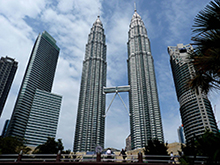Petronas Towers
The Petronas Towers, also known as the Petronas Twin Towers are twin skyscrapers in Kuala Lumpur, Malaysia. According to the Council on Tall Buildings and Urban Habitat (CTBUH)'s official definition and ranking, they were the tallest buildings in the world from 1998 to 2004 and remain the tallest twin towers in the world. The buildings are a landmark of Kuala Lumpur, along with nearby Kuala Lumpur Tower.
The towers were designed by Argentine architect César Pelli. A distinctive postmodern style was chosen to create a 21st-century icon for Kuala Lumpur. Planning on the Petronas Towers started on 1 January 1992 and included rigorous tests and simulations of wind and structural loads on the design. Seven years of construction followed at the former site of the original Selangor Turf Club, beginning on 1 March 1993 with excavation, which involved moving 500 truckloads of earth every night to dig down 30 metres (98 ft) below the surface.
 The construction of the superstructure commenced on 1 April 1994. Interiors with furniture were completed on 1 January 1996, the spires of Tower 1 and Tower 2 were completed on 1 March 1996, 3 years after its construction was started, and the first batch of Petronas personnel moved into the building on 1 January 1997. The building was officially opened by the Prime Minister of Malaysia's Tun Dr. Mahathir bin Mohamad on 1 August 1999.
The construction of the superstructure commenced on 1 April 1994. Interiors with furniture were completed on 1 January 1996, the spires of Tower 1 and Tower 2 were completed on 1 March 1996, 3 years after its construction was started, and the first batch of Petronas personnel moved into the building on 1 January 1997. The building was officially opened by the Prime Minister of Malaysia's Tun Dr. Mahathir bin Mohamad on 1 August 1999.
The twin towers were built on the site of Kuala Lumpur's race track. Test boreholes found that the original construction site effectively sat on the edge of a cliff. One half of the site was decayed limestone while the other half was soft rock. The entire site was moved 61 metres (200 ft) to allow the buildings to sit entirely on the soft rock. Because of the depth of the bedrock, the buildings were built on the world's deepest foundations. 104 concrete piles, ranging from 60 to 114 metres (197 to 374 ft) deep, were bored into the ground. The concrete raft foundation, comprising 13,200 cubic metres (470,000 cu ft) of concrete was continuously poured through a period of 54 hours for each tower. The raft is 4.6 metres (15 ft) thick, weighs 32,500 tonnes (35,800 tons) and held the world record for the largest concrete pour until 2007. The foundations were completed within 12 months by Bachy Soletanche and required massive amounts of concrete. The Petronas Towers' structural system is a tube in tube design, invented by Fazlur Rahman Khan. Applying a tube-structure for extreme tall buildings is a common phenomenon. More details
The towers were designed by Argentine architect César Pelli. A distinctive postmodern style was chosen to create a 21st-century icon for Kuala Lumpur. Planning on the Petronas Towers started on 1 January 1992 and included rigorous tests and simulations of wind and structural loads on the design. Seven years of construction followed at the former site of the original Selangor Turf Club, beginning on 1 March 1993 with excavation, which involved moving 500 truckloads of earth every night to dig down 30 metres (98 ft) below the surface.
 The construction of the superstructure commenced on 1 April 1994. Interiors with furniture were completed on 1 January 1996, the spires of Tower 1 and Tower 2 were completed on 1 March 1996, 3 years after its construction was started, and the first batch of Petronas personnel moved into the building on 1 January 1997. The building was officially opened by the Prime Minister of Malaysia's Tun Dr. Mahathir bin Mohamad on 1 August 1999.
The construction of the superstructure commenced on 1 April 1994. Interiors with furniture were completed on 1 January 1996, the spires of Tower 1 and Tower 2 were completed on 1 March 1996, 3 years after its construction was started, and the first batch of Petronas personnel moved into the building on 1 January 1997. The building was officially opened by the Prime Minister of Malaysia's Tun Dr. Mahathir bin Mohamad on 1 August 1999.The twin towers were built on the site of Kuala Lumpur's race track. Test boreholes found that the original construction site effectively sat on the edge of a cliff. One half of the site was decayed limestone while the other half was soft rock. The entire site was moved 61 metres (200 ft) to allow the buildings to sit entirely on the soft rock. Because of the depth of the bedrock, the buildings were built on the world's deepest foundations. 104 concrete piles, ranging from 60 to 114 metres (197 to 374 ft) deep, were bored into the ground. The concrete raft foundation, comprising 13,200 cubic metres (470,000 cu ft) of concrete was continuously poured through a period of 54 hours for each tower. The raft is 4.6 metres (15 ft) thick, weighs 32,500 tonnes (35,800 tons) and held the world record for the largest concrete pour until 2007. The foundations were completed within 12 months by Bachy Soletanche and required massive amounts of concrete. The Petronas Towers' structural system is a tube in tube design, invented by Fazlur Rahman Khan. Applying a tube-structure for extreme tall buildings is a common phenomenon. More details
